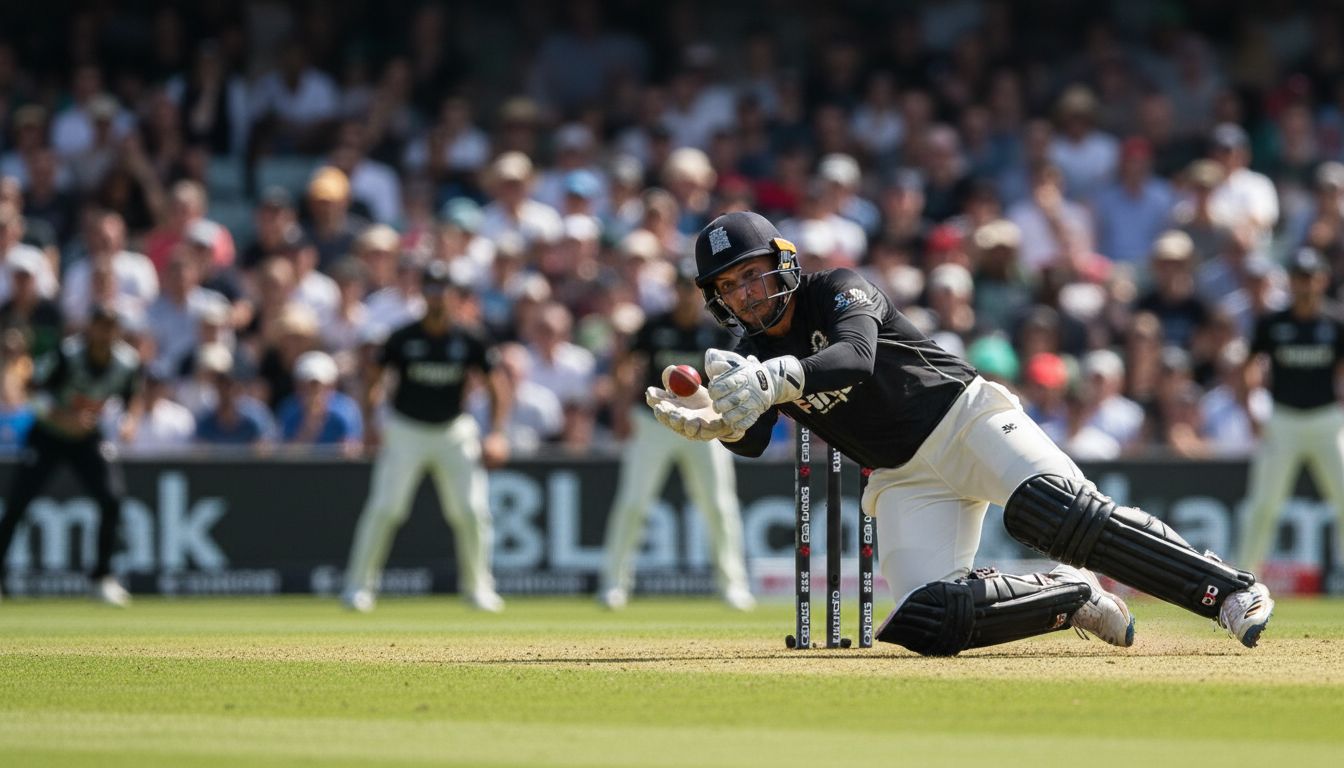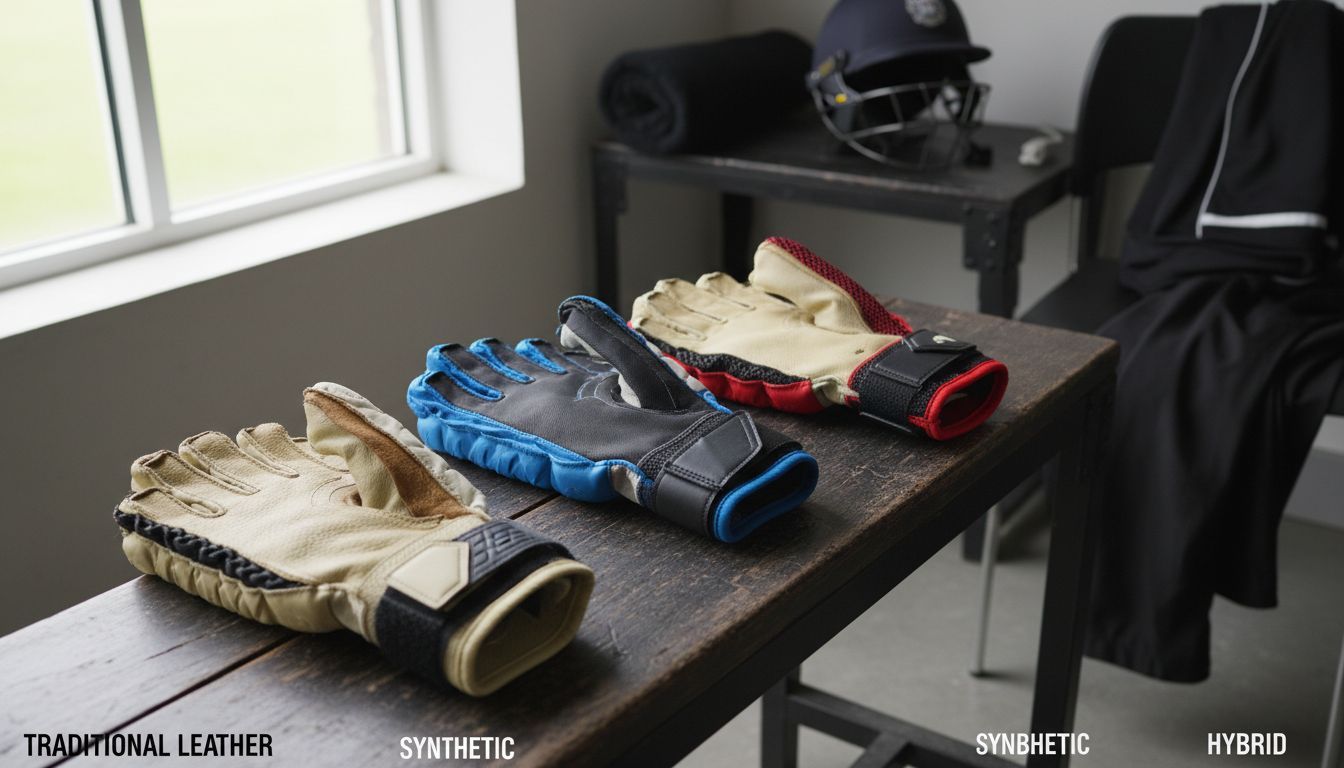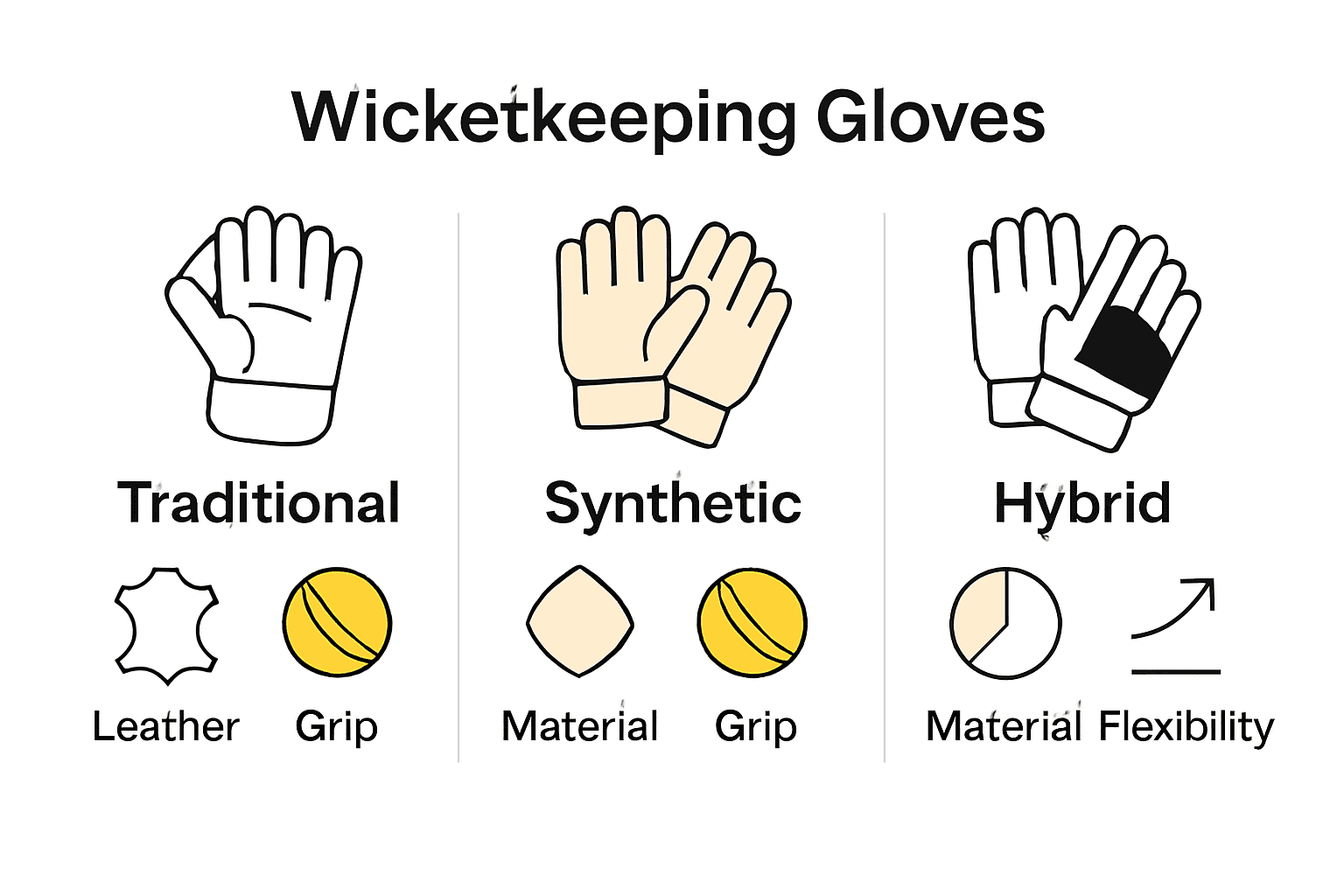Complete Guide to the Role of Wicket Keeping Gloves

Most american cricket enthusiasts are surprised to learn that wicket-keeping gloves absorb the force of balls traveling at speeds over 90 miles per hour. With so much riding on safety and split-second reactions, the right gloves make all the difference for players behind the stumps. Whether you follow cricket as a fan or step onto the field yourself, understanding how wicket-keeping gloves protect hands and improve performance is essential for any serious approach to the game.
Table of Contents
- Defining The Role Of Wicket Keeping Gloves
- Types Of Wicket Keeping Gloves Explained
- Key Features And Construction Standards
- How Gloves Improve Performance And Safety
- Proper Care And Maintenance Guidelines
- Legal Requirements And Equipment Standards
Key Takeaways
| Point | Details |
|---|---|
| Function of Wicket-Keeping Gloves | These gloves protect players’ hands from high-velocity balls and enhance their catching abilities. |
| Types of Gloves | Wicket-keeping gloves are available in traditional leather, synthetic, and hybrid designs, each catering to different playing conditions. |
| Performance and Safety | Quality gloves improve grip and hand protection, thereby enhancing a player’s performance and reducing the risk of injuries. |
| Maintenance Practices | Proper care, including cleaning and storage, is essential to extend the life and performance of wicket-keeping gloves. |
Defining the Role of Wicket Keeping Gloves
Wicket-keeping gloves are specialized protective equipment designed to shield a cricket player’s hands during critical moments of play. According to the English Cricket Board, these gloves are essential for injury prevention, serving as a critical barrier between the wicket-keeper’s hands and high-velocity cricket balls.
The primary function of wicket-keeping gloves extends beyond simple protection. As documented by Wikipedia, these large leather gloves are specifically engineered to help wicket-keepers catch balls bowled by the bowler, hit by a batter, or thrown by fielders. Their specialized design includes enhanced padding and reinforced areas to absorb intense impact while maintaining the player’s grip and dexterity.
Wicket-keeping gloves differ significantly from standard batting or fielding gloves. They feature unique characteristics like extended webbing between fingers, extra cushioning around the palm and fingers, and a more robust construction that allows quick, precise movements. This specialized design enables wicket-keepers to perform complex tasks such as catching fast deliveries, stumping batters, and maintaining split-second reaction times throughout a cricket match.
Key features of high-quality wicket-keeping gloves include:
- Advanced shock absorption technology
- Reinforced finger sections
- Breathable materials for comfort
- Enhanced grip mechanisms
- Flexible yet protective design
Choosing the right wicket-keeping gloves can dramatically impact a player’s performance and safety on the cricket field. Types of Wicketkeeping Gloves: Complete Guide offers comprehensive insights into selecting the most suitable gloves for different playing conditions and skill levels.
Types of Wicket Keeping Gloves Explained
Wicket-keeping gloves come in several distinct varieties, each designed to meet specific playing conditions and performance requirements. According to Wikipedia, these gloves feature a unique anterior surface engineered for catching balls, with specialized rubber construction and traction-enhancing elements like strategic bumps to improve grip and impact absorption.
The primary categories of wicket-keeping gloves include traditional leather gloves, synthetic material gloves, and hybrid design gloves. Traditional leather gloves offer superior durability and classic protection, while synthetic options provide enhanced flexibility and lighter weight. Hybrid designs combine the best attributes of both materials, delivering optimized performance for modern cricket players.

Advanced wicket-keeping gloves are characterized by their specialized construction features:
- Reinforced finger protection
- Shock-absorbing padding
- Moisture-wicking inner linings
- Adjustable wrist straps
- Advanced grip technologies
Players must consider multiple factors when selecting wicket-keeping gloves, including hand size, playing conditions, and personal comfort preferences.
 For comprehensive guidance on selecting the perfect pair, Understanding the Types of Cricket Gloves: A Comprehensive Guide provides in-depth insights into matching glove characteristics with individual player needs.
For comprehensive guidance on selecting the perfect pair, Understanding the Types of Cricket Gloves: A Comprehensive Guide provides in-depth insights into matching glove characteristics with individual player needs.
Key Features and Construction Standards
Wicket-keeping gloves represent a sophisticated piece of cricket equipment with precise engineering requirements. Wikipedia highlights that the critical design focuses on a specialized catching surface made of rubber with strategic traction-enhancing features, complemented by soft padding materials designed to reduce ball impact significantly.
The construction standards for wicket-keeping gloves involve multiple critical components that ensure optimal performance and player protection. These standards include rigorous specifications for material quality, impact resistance, flexibility, and ergonomic design. Professional-grade gloves undergo extensive testing to meet international cricket regulations, which mandate specific padding thickness, grip characteristics, and durability requirements.
Key construction elements that define high-quality wicket-keeping gloves include:
- Reinforced palm webbing
- Multi-layered shock absorption zones
- Breathable inner membrane
- Seamless finger construction
- Precision-engineered grip patterns
- Temperature-adaptive materials
Understanding these intricate design standards helps players select gloves that provide maximum protection and performance.
For players seeking deeper insights into cricket gear selection, How to Select Cricket Gloves for Perfect Fit and Protection offers comprehensive guidance on matching individual needs with advanced glove technologies.
How Gloves Improve Performance and Safety
Cricket wicket-keeping gloves play a pivotal role in player protection and performance enhancement. Heega Sports emphasizes that quality gloves significantly improve a player’s capabilities by providing superior grip, enhanced flexibility, and comprehensive hand protection, which directly translates to quicker reflexes and reduced injury risks.
The performance benefits of advanced wicket-keeping gloves extend far beyond basic protection. These specialized gloves enable wicket-keepers to execute complex catching techniques with greater confidence and precision. By minimizing hand fatigue and absorbing high-impact ball strikes, players can maintain consistent performance throughout extended match durations, ultimately improving their overall defensive capabilities.
Key performance and safety advantages of high-quality wicket-keeping gloves include:
- Shock absorption to reduce hand strain
- Enhanced tactile sensitivity
- Improved grip under various weather conditions
- Reduced risk of hand and finger injuries
- Increased reaction time capabilities
- Temperature and moisture management
Understanding the intricate relationship between glove design and player performance helps cricketers make informed equipment choices. For comprehensive insights into cricket safety gear, 7 Key Items in Your Cricket Safety Equipment List provides additional context on protecting yourself during play.
Proper Care and Maintenance Guidelines
Maintaining wicket-keeping gloves requires a systematic approach to preserve their performance, durability, and protective qualities. Proper care begins with understanding the unique materials and construction of these specialized cricket accessories, which demand specific handling and cleaning techniques to extend their functional lifespan.
Glove maintenance involves several critical steps that help prevent premature wear and maintain optimal performance. Players should develop a consistent routine that includes careful cleaning, appropriate drying, strategic storage, and periodic inspection for potential damage. The goal is to protect the gloves’ structural integrity, preserve their grip characteristics, and ensure maximum protection during cricket matches.
Key maintenance practices for wicket-keeping gloves include:
- Gentle hand cleaning with mild soap
- Air drying at room temperature
- Avoiding direct heat sources
- Storing in cool, dry environments
- Removing excess moisture after use
- Periodic leather conditioning
- Checking for structural wear and tear
- Replacing worn padding and webbing
Cricketers seeking comprehensive equipment care guidance can explore Role of Cricket Gloves: Complete Guide for Players for additional insights into maintaining high-performance cricket gear and extending the useful life of their specialized equipment.
Legal Requirements and Equipment Standards
The legal framework governing wicket-keeping gloves is complex and strictly regulated by international cricket organizations. International Cricket Council regulations provide specific guidelines about glove construction, explicitly stating that webbing between fingers is prohibited, with the sole exception of allowable support between the index finger and thumb.
The equipment standards for wicket-keeping gloves are comprehensive and designed to maintain fair play and player safety. Cricket Australia playing conditions uniquely recognize wicket-keepers as the only fielders permitted to wear specialized gloves and external leg guards, which are considered part of the player’s physical equipment during match play.
Key legal requirements and standards for wicket-keeping gloves include:
- Strict webbing restrictions
- Maximum padding thickness limits
- Grip material specifications
- Color and design regulations
- Impact absorption standards
- Material composition guidelines
- Weight and flexibility parameters
For cricketers seeking to understand equipment compliance thoroughly, Understanding the Role of Gloves in Cricket provides additional insights into navigating complex equipment regulations and standards.
Elevate Your Game with the Perfect Wicket-Keeping Gloves
Wicket-keeping gloves are essential for both protection and peak performance on the cricket field. This guide highlights how specialized gloves with reinforced padding, advanced grip technology, and proper fit can reduce injuries and boost reaction times. If you have struggled to find gloves that provide both comfort and safety, it is time to upgrade your gear with expertly designed options.

Discover a wide selection of premium wicket-keeping gloves tailored to your playing style at CricketKingdom.co.uk. Benefit from our detailed guides like Types of Wicketkeeping Gloves: Complete Guide and How to Select Cricket Gloves for Perfect Fit and Protection to make the best choice with confidence. Act now to enjoy free delivery on orders over £100 and elevate your safety and game performance today.
Frequently Asked Questions
What are wicket-keeping gloves?
Wicket-keeping gloves are specialized protective equipment designed to shield a cricket player’s hands while catching high-velocity balls, stumping, and performing quick reflex tasks behind the stumps.
How do I choose the right wicket-keeping gloves?
When selecting wicket-keeping gloves, consider factors such as hand size, the playing conditions, the glove material (leather or synthetic), and personal comfort preferences. Assessing these aspects will help you find the most suitable gloves for your needs.
What are the key features of high-quality wicket-keeping gloves?
High-quality wicket-keeping gloves should possess advanced shock absorption technology, reinforced finger sections, breathable materials for comfort, enhanced grip mechanisms, and a flexible yet protective design for optimal performance and safety.
How should I maintain my wicket-keeping gloves?
To maintain your wicket-keeping gloves, clean them gently with mild soap, air dry at room temperature, avoid direct heat, store them in a cool, dry place, and check periodically for wear and tear to ensure they remain effective and durable.
Recommended
- Types of Wicketkeeping Gloves: Complete Guide – The Cricket Kingdom
- Role of Cricket Gloves: Complete Guide for Players – The Cricket Kingdom
- Understanding the Role of Gloves in Cricket – The Cricket Kingdom
- Understanding What Are Wicket Keeping Pads – The Cricket Kingdom


